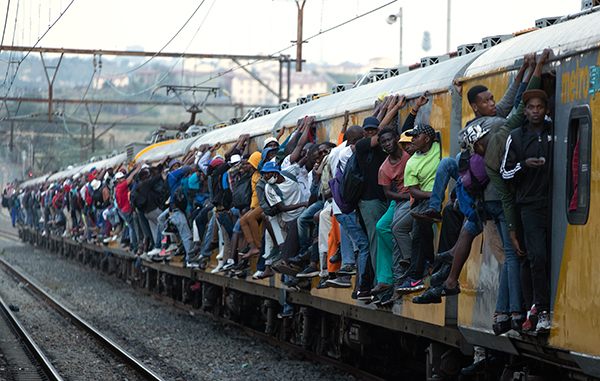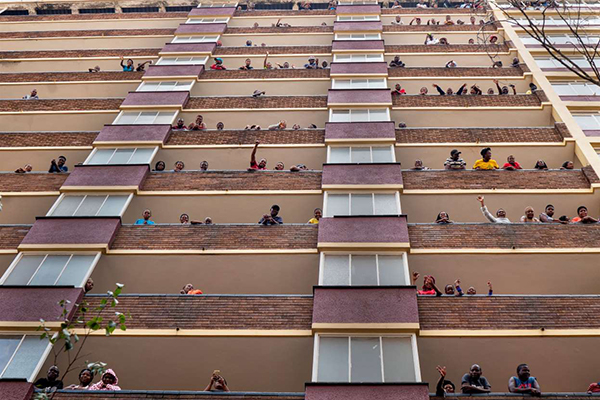Coronavirus — and Global Countermeasures:
A Gathering Tsunami of Pain in a World of Savage Inequalities
| revcom.us
Editors’ Note: Even while drastic public measures are necessary to limit the devastation caused by the COVID-19 pandemic, in the world of savage inequalities of capitalist-imperialism these measures themselves are worsening horrific suffering among billions of people around the world who live on the edge of survival even in normal times. Two out of three human beings on our planet—five billion people, out of a world population of more than seven billion—live on less than $10 a day, and 750 million on less than $1.90 a day, the international “official” line of extreme poverty. These are people who get up every day and spend 12 or 14 hours trying to scratch together enough food to feed their children, and then—succeed or fail—get up the next day and try to do it again.
Yet these are precisely the people most at risk from the disease. They live packed together in huge slums where people may live eight to a room, or many people sleeping in shifts in one bed; where social distancing is nearly impossible. They often lack access to clean running water or soap to wash. They are disproportionately wracked with malnutrition, tuberculosis, diabetes, and other conditions that make them more likely to die from COVID-19.
Under this system of capitalism-imperialism, it is no exaggeration to say that billions face stark circumstances and “choices” of hunger, heightened risk of infection, and repressive measures in a time of crises.
The system created these conditions—and continually replicates and intensifies them. It is beyond the functioning of this system to both take all the measures needed to combat this pandemic, and to organize immediate and necessary relief for the most vulnerable globally to minimize the suffering that those measures give rise to. It is the responsibility of all with a heart and a conscience to once and for all recognize the barbaric nature of this outmoded system that has created this nightmare, and do the necessary work to get rid of it, at the earliest possible time.
India:
People Face a Potential Health Catastrophe ... and the Public Health Measures of a Fascist Regime
COVID-19 poses a catastrophic threat to India’s 1.3 billion people that could dwarf the devastation so far in China, Europe, and the U.S.
Though as of March 29 there are just over 1,000 confirmed cases, little testing has gone on so there are likely far more infected people. And there is a particular danger from the fact that India’s hundreds of millions of desperately poor people often live packed together in dense slums, often with seven or eight people sharing a room, old and young together. The city of Mumbai has 18 million people and is almost three times as densely populated as New York City.
Under these conditions, COVID-19 could spread like wildfire, infecting many millions. India’s healthcare system will be swamped—it is ranked 145 on the global scale of healthcare quality and access. India has less than one-fourth as many hospital beds per person as the U.S., and less than one doctor for every thousand people.
After months of inaction as the epidemic raged in neighboring China, on March 24 India’s fascist leader Narendra Modi announced emergency measures to start four hours later. People were suddenly restricted to their homes, with no time to prepare. The poor who struggle to eat day to day suddenly had no way to earn money.
Measures were enforced with fascist brutality—one state minister issued “shoot on sight” orders for anyone violating them. Around the country police were beating store owners, the poor, journalists. And the government has so far offered a pittance in food aid and $7 a month in cash.
A mother of three in a New Delhi tenement told the New York Times: “The police beat us if we try to step out. We dare not step out even to buy vegetables whose prices have skyrocketed. The future looks very dark. If coronavirus does not kill us, hunger will.”
With no way to earn a living amid India's coronavirus clampdown, thousands of migrants workers packed into bus stations in New Delhi in a desperate attempt to get home https://t.co/YYmDa0fnTB pic.twitter.com/1hvmOLW5MV
— Reuters (@Reuters) March 29, 2020
Iran:
Iran Faces Major Outbreak: Caught in the Vice of a Theocratic Regime and U.S. Economic Strangulation
Iran is one of the hardest hit countries, with more than 38,000 confirmed cases (as of March 29) and more than 2,600 deaths. Some Iranian researchers believe the epidemic “will peak around late May and could result in 3.5 million deaths.”
In addition, as many as 480 people died from drinking methanol (wood alcohol) after rumors spread on social media that it could cure COVID-19.1 Thousands more were injured: a five-year-old boy on a breathing apparatus was given methanol by his desperate parents and was blinded by it.
Though it had a fairly good health care system, Iran has almost six times as many confirmed COVID-19 cases as any other Middle Eastern country, and a high death rate. Why?
One reason is that Iran’s theocratic, oppressive government downplayed or suppressed news of the outbreak for political reasons until it was already widespread (much as Trump did in the U.S.).
Another driving reason is the impact of sanctions imposed by the U.S., which for years sought to make the Iranian regime “compliant” with U.S. interests—or push for its overthrow—by bankrupting the Iranian economy. Sanctions contributed to an ongoing economic crisis and shortage of medical supplies, even before the COVID-19 epidemic.
Now sanctions are strangling efforts to combat COVID-19.2 According to two Iran scholars:
Iran needs financial and medical resources—from food and medicine to cash transfers—to carry out an effective nationwide quarantine and other measures to curb the outbreak.... Pirouz Hanachi, the mayor of Tehran, explained that a quarantine was nearly impossible to enforce because the government would be unable to financially support people unable to work.
...a majority of the population would be devastated by a long period of not being able to earn a living. Compounding this is a shortage of medicine and medical equipment including ventilators, testing kits and general respiratory equipment to combat the contagion.
On March 20, the U.S. announced it would not relax sanctions, even in the midst of the epidemic, and even while major voices in the Trump/Pence regime like Secretary of State Mike Pompeo and National Security Advisor Robert O'Brien fight for ratcheting up aggression against Iran, sensing particular opportunities and vulnerabilities of the Iranian regime at this moment.
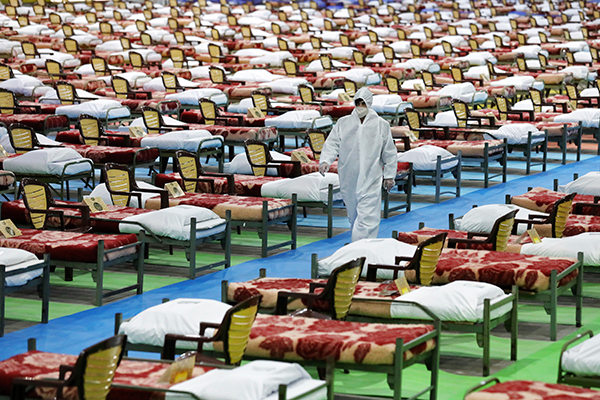
Thousands of beds await the next surge of COVID-19 patients in Iran; already the disease has infected at least 38,000 people and killed over 2,600. Photo: AP
1. The source of the rumor was a British tabloid that claimed COVID-19 could be cured with whiskey and honey. Under the Islamic theocratic government, alcoholic beverages are illegal in Iran, so bootleg alcohol, some containing methanol, was peddled instead. [back]
2. For more on the devastating impact of U.S. sanctions, see Common Dreams, March 11, 2020, and Slate, March 18, 2020. [back]
Brazil:
Bolsonaro Denies Coronavirus Threat as COVID-19 Cases Surge
Brazil is the largest and most populated country in Latin America; 20 percent of its 200 million people live in poverty, millions in the wretched favelas (slums) that surround major cities. Many don’t have access to clean water with which to wash their hands.
So coronavirus is a major threat in Brazil, and is spreading rapidly. Brazil had one confirmed case one month ago; as of March 29, it has more than 4,200, and more than 136 people have died.
In response, Brazilian president Jair Bolsonaro—a fascist friend and admirer of Trump—has stepped forward as the world’s leading “coronavirus denier,” spouting anti-scientific nonsense about why COVID-19 is nothing to worry—or do anything—about. Bolsonaro claimed that Brazilians “never catch anything,” even after “jumping into the sewage.” He said that Brazilians have “antibodies that help it not to proliferate.” He said that “90% of us will have no symptoms if contaminated.” He said, “Other viruses have killed many more than this one and there wasn’t all this commotion.”
And it’s not just words—Bolsonaro went ahead with the massive Carnival festivities in which millions are in the streets, dancing and drinking—the perfect situation for the virus to spread widely and rapidly.
Sharp struggle has erupted in Brazil over all this, both within the ruling class and among the masses. Governors and mayors of some of Brazil’s largest states and cities defied Bolsonaro and imposed lockdowns to slow the virus; Bolsonaro denounced these shutdowns as “a crime. They’re destroying Brazil.” Bolsonaro’s own health minister warned, “Clearly, by the end of April, our health care system will collapse.” Even powerful drug-trafficking gangs in Rio de Janeiro ordered curfews in areas they control, saying, “If the government doesn’t have the capacity to handle this, organized crime will.”
And even under conditions of the epidemic, sections of the masses have gone out on their balconies at a designated time, banging on pots, switching their lights on and off, and shouting “Bolsonaro Out!” BBC estimated that on March 19, millions took part.
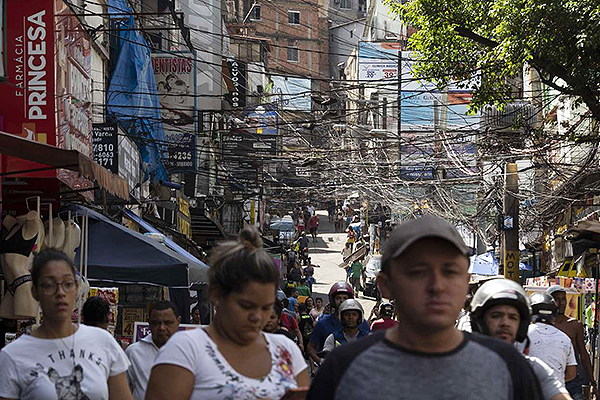
Twenty percent of Brazil's 200 million people live in poverty, millions in the wretched favelas (slums) that surround major cities. Many don’t have access to clean water with which to wash their hands. Here a photo of Rocinha Favela, the largest favela in Brazil, located in Rio de Janeiro. Photo: AP
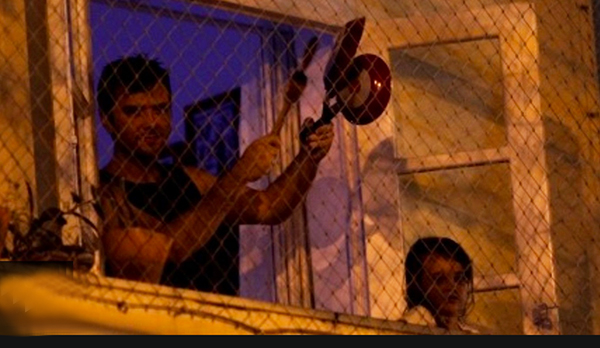 Even under conditions of the epidemic, sections of the masses have gone out on their balconies at a designated time, banging on pots, switching their lights on and off, and shouting “Bolsonaro Out!” BBC estimated that on March 19, millions took part. Photo: BBC screengrab
Even under conditions of the epidemic, sections of the masses have gone out on their balconies at a designated time, banging on pots, switching their lights on and off, and shouting “Bolsonaro Out!” BBC estimated that on March 19, millions took part. Photo: BBC screengrab
Mexico:
A Hidden Epidemic?
The government of Mexico’s “progressive” president Andrés Manuel López Obrador (known as AMLO) has echoed fascist leaders like Bolsonaro in first denying or downplaying the coronavirus threat and opposing necessary measures to slow its spread. “We don’t want to have a cure that is costlier in social terms than the actual illness,” said the country’s sub-secretary of health. The governor of Puebla claimed that the poor “are immune” from coronavirus. And according to the New York Times, March 25:
[AMLO] has continued to wade into crowds and kiss babies. Ruling out travel restrictions, business closings or quarantine orders, last week Mr. López Obrador suggested Mexico would be spared by divine intervention as he held up two amulets he called “my bodyguards.”
“Do not panic, and please do not stop going out,” he said in a video Sunday night. “If you have the economic capacity, keep taking your families to restaurants, because that means strengthening the family and popular economy.”
Part of the government’s justification is that Mexico appears to have few infections—only 717 confirmed cases as of March 28. But the reality is that hardly anyone has been tested—the Los Angeles Times reports that as of March 25, the government had tested only 3,000 people, and that private hospitals were waiting a week or more for test results. But Mexican health officials who have studied the situation estimate that 250,000 Mexicans could contract COVID-19 and 10,000 would require intensive care in hospitals.
According to the Los Angeles Times, health care workers who will be on the front lines have already begun to protest the lack of preparedness, holding strikes and walkouts around the country. “‘We can’t work without equipment,’ implored a nurse in Tabasco state in a widely viewed video on Twitter. ‘We also have families—children and parents.’”
A particularly grave danger is that the disease will spread among the tens of thousands of asylum seekers who were turned back by the U.S., and are now living in squalid conditions along the border.
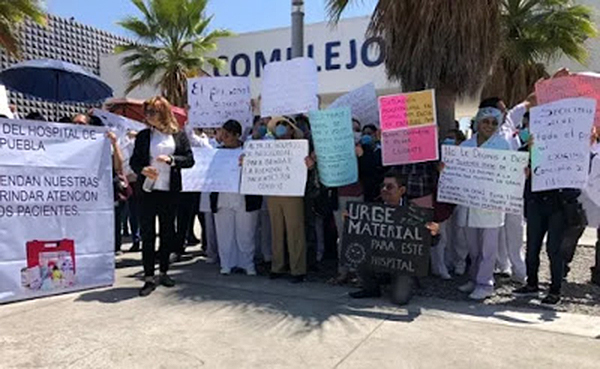
Healthcare workers in Mexico protest lack of protective gear against COVID-19. Photo: Aurora Rojas.blogspot
Africa:
A Gathering Threat
Although the African continent was not hard hit by the first waves of coronavirus, at this point there are the beginnings of epidemics evident in South Africa (1,280 confirmed cases), and in the northern Africa countries of Egypt, Algeria, and Morocco, with between four and six hundred cases each. And the 46 African states had a total of 3,426 positive cases (as of March 27).
Looking at the pattern in the rest of the world, it seems likely that many or most of these countries will end up with significant outbreaks of the disease, which will hit especially hard due to the intense poverty and weak health care systems that mark most of them.
On March 27, the South African government put a three-week stay-at-home order in effect to slow the coronavirus.
South Africa’s agriculture, mining, and industry are a source of tremendous wealth to imperialist nations like the U.S. and Britain, to the wealthy whites who openly ran the country until the 1990s and continue to have major power, and to a new class of black capitalists who now share in the plunder. But all of this is built on the backs of tens of millions of bitterly exploited workers and farm laborers, millions of whom live in crowded urban shantytowns and dormitories where millions live with no clean water and little or no access to health care, or in rural settlements where large numbers share latrines or line up for food and water, making social distancing impossible. These millions are incredibly vulnerable to COVID-19... but will also be put in desperate straits almost immediately by the shutdown because they have no savings and now have little or no income.
South Africa also has a large number of people who are HIV positive or have tuberculosis, asthma, or diabetes—all conditions that make people very vulnerable to dying from COVID-19. And the medical system is overburdened even in normal times. Atiya Mosam, a medical doctor and co-founder of Public Health Action Team, said, “If the virus spreads like it has in China or Italy or the United States, it’s going to be very difficult for South Africa to respond. We cannot afford that.”
Europe:
Italy, Spain, France, Germany, and the UK
Western Europe is one of the wealthiest regions in the world, having reaped the gains of centuries of colonialism, slavery, and capitalism-imperialism. It has state-of-the-art medical technology, relatively extensive health care systems, and many scientists and scientific institutions that have a fairly deep understanding of how pandemics start... and how to stop or slow them.
Nonetheless, three full months after China reported the dangerous new coronavirus to the World Health Organization, and 10 weeks after the full-blown epidemic there that ultimately killed at least 3,000 people, COVID-19 is still tearing through these countries in a wave-like pattern, killing over 20,000 people already, and apparently still accelerating. This is putting a glaring spotlight on the deep systemic problems of health care even in wealthy capitalist-imperialist countries, and, in many cases, the added problem of most of these governments ignoring the warnings of scientists until the virus was out of control.
In Italy, the first COVID-19 case was confirmed on January 29, but the government did not begin to take serious measures to slow its spread until February 22, and did not declare a national lockdown until March 9. At this writing, there are almost 100,000 confirmed cases, and nearly 11,000 deaths. Hospitals have been completely overwhelmed for weeks, with doctors describing “war-time conditions,” having to make decisions as to which patients to try and save and which to abandon to death.
Spain and France were next.
In spite of what was happening in Italy, the Spanish government took few steps to prevent an outbreak there and scoffed at the danger. In mid-February, while discussing whether to cancel a massive tech conference, Spain’s Minister of Health declared, “There is no need to take any other measure than those that have been taken.” Another official reportedly asked, “Do you think it [coronavirus] really even exists?” As of March 29, the government’s website guidance for “protecting yourself and others” does not even mention social distancing—in a country where a kiss on the cheek is the customary greeting. Only on March 13 was a “state of alarm” declared and limited rules for social distancing imposed. As of this writing, there are more than 80,000 confirmed cases and 6,800 deaths.
On March 10, when France had about 1,000 confirmed cases, at that time the second highest total in Europe, the attitude of French president Macron was to not “panic” people, to insist on a “region-by-region approach,” and to insist on a “proportional” response to the epidemic. Nineteen days later, France has more than 40,000 confirmed cases, and more than 2,600 people have died.
In Britain too, the government, led by Prime Minister Boris Johnson, a close Trump ally, trivialized the danger, sometimes in truly disgusting ways. In one phone conversation, Johnson reportedly referred to plans to ramp up production of life-saving ventilators as “Operation Last Gasp.” Even in mid-March, Johnson batted about the idea of letting the virus run its course so that British people would develop “herd immunity” (which happens after the majority of people have contracted an infection and, hopefully, developed ongoing immunity to it). He refused to shut down schools, organize widespread testing, or take seriously the problem of lack of personal protective equipment for health care providers—much less order a national lockdown.
Only in late March, when coronavirus deaths hit 335, did the government finally act. On March 23, Johnson ordered all Britons to stay at home and ordered all nonessential businesses closed. Two days later, Prince Charles (heir to the British throne) tested positive. On March 27, Johnson himself tested positive, and a few hours later, so did his top health minister and chief medical advisor. As of March 29, Britain has almost 20,000 cases and more than 1,200 people have died.
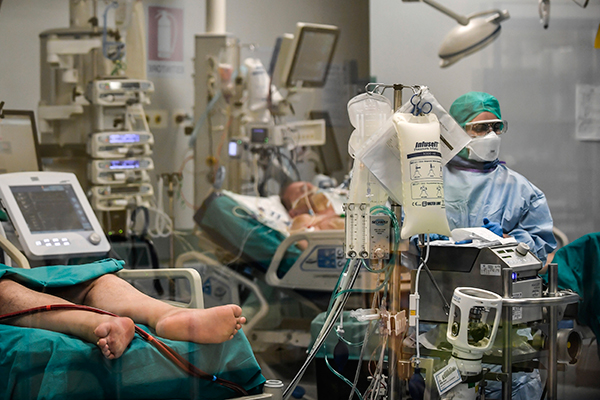
Doctors work on COVID-19 patients in the intensive care unit of San Matteo Hospital, in Pavia, northern Italy, Thursday, March 26. Photo: AP
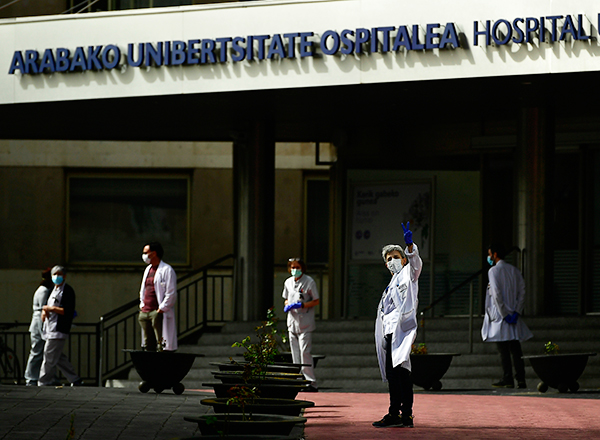
Health services staff members protest outside the Txagorritxu hospital demanding more protection equipment in a hospital, in Vitoria, Spain, March 20. Photo: AP
Some people have pointed to Germany as a “better-case scenario.” Though Germany has more than 62,000 confirmed cases as of March 29, only 541 people have died. (Compare this to France with far fewer cases—40,000+—but far more deaths—more than 2,600.) This may be related to the fact that Germany has the richest economy in Europe, and also that its leader, Chancellor Angela Merkel, seemed to treat the pandemic more seriously from early on, including organizing testing on a wide scale, which is important in containing or slowing the spread of the disease, and also in making sure people who need treatment get treatment. But it is really too soon to draw conclusions about the trajectory of the disease in different countries in Europe, because the virus took root in different countries at different times, and because the level of testing varies widely from country to country. (In fact, deaths in Germany, too, are now accelerating at a fairly brisk clip.)
However, it is not too soon to say that these bourgeois governments were criminally negligent in failing to act on the almost universal understanding of epidemiologists and public health officials, going back to early January, that without major intervention and preparation by all the world’s governments, COVID-19 had the potential to become the worst public health crisis in a century. For reasons having largely to do with the fundamental nature and functioning of the underlying system of capitalism-imperialism, and the conscious policies of its rulers, these governments disregarded this and were virtually completely unprepared, tens of thousands have already died, tens of thousands more (at least) will die unnecessarily, and a level of unprecedented economic suffering is being imposed on the people of the world because of these failures.
Get a free email subscription to revcom.us:

Volunteers Needed... for revcom.us and Revolution

